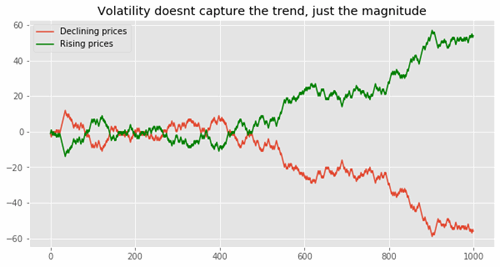The word volatility is used a lot in the investment industry, often, in a negative tone because it tends to spike when stock markets fall.
But this doesn’t capture the entire picture. Volatility can be a good thing for investors and stock markets in general. In this blog we’ll explain how, but first, we’ll explain what volatility is.
What is volatility?
Volatility is a statistical measure that captures the size of moves seen by an investment, like a share, moving up or down over a set period. The higher the volatility, the larger the dispersion of those moves - as the two graphs below show.

Volatility is everywhere
It is present in all financial market instruments, including bonds, shares, commodities (e.g. oil, gold), and property prices. All investment types come with volatility, and the more volatility that comes with an investment, the more returns an investor should potentially receive.
Another term for volatility in the investment industry is risk. You may have heard the term, “No risk, no reward”, well the same applies to volatility; low volatility of an investment typically means lower potential returns.
That is why cash in a bank account with minimal volatility compared to other investment types carries the smallest level of returns. Shares, on the other hand, come with much higher volatility than cash, but investors would expect higher returns.
Volatility can vary for investments determined by circumstances
Volatility is not just a measuring tool to compare investments with each other, as for any given investment the volatility is in a constant state of flux, and is unlikely to be the same if measured at two different points in time.
Why? There are many reasons.
It could be due to the company, sector, or even market-wide circumstances. Company-specific circumstances that could dramatically affect volatility typically focus on worse than anticipated results, scandals, loss of competitive edge, change of consumer behaviour, or regulatory change.
How is volatility measured?
Without getting too technical, there are two commonly used ways to measure volatility.
Volatility measured by Standard Deviation
Firstly, there is Standard Deviation which measures the absolute level of each change in a time period relative to the average, for example, daily changes compared against average movements.
The bigger the difference between the average change and daily change, the higher the Standard Deviation, and the greater the volatility. This is an absolute measure of volatility as it is based on the underlying numbers of the investment alone.
Volatility measured by Beta
Secondly, there is something called Beta, which is a tool used to measure the volatility of an investment versus the wider market it sits in. Simply put, the market always has a beta of 1, and the investment will have a beta higher, equal to, or lower than the market.
For example, HSBC is in the UK’s biggest stock market, the FTSE 100, which in this example is the market. The FTSE 100, therefore, always has a beta of 1 as you are comparing it to itself.
If HSBC had a beta of 1.2, it would imply that it is 20% more volatile than the wider market, but if it had a beta of 0.80, then it would suggest that HSBC is 20% less volatile than the FTSE 100.
Beta is a quick way to gauge how much an investment moves compared to broad financial markets and sectors. This is a relative measure of volatility as you are comparing a stock to the market that it comes from.
So, why is volatility a good thing for stock markets?
One of the main arguments why volatility is a good thing for stock markets is because, without it, they wouldn’t function correctly. A healthy stock market needs consequences for what can sometimes be described as irrational behaviour.
And one of those consequences includes large price declines with high volatility. But why does the stock market care about consequences?
Because if prices were allowed to continue to go up or down with no rhyme or reason, over a long investment horizon, there would be no capital markets as investors wouldn’t be able to predict how investments or markets are going to perform.
It would then become a game of luck and would resemble betting on a horse in the hope that it wins. Consequences for irrational behaviour like volatility keeps the market well attended by investors as it creates order and rules from chaos.
Here are two examples of how volatility is vital to a healthy stock market.
It’s a reminder of what happens when excess and exuberance go too far
Excess and exuberance are often associated with fear’s cousin, greed, which can lead to bubbles in investment prices.
A bubble in finance is when the price of an asset (investment) floats higher without any tangible support, like a game-changing acquisition or a breakthrough which pushes the price higher.
They are called bubbles because when they burst, there is nothing or little between the share price and a large drop. Well known bubbles from the investing history books include the Dutch Tulip Mania, the Dot-Com boom of the ’00s, and the United States housing market that burst in 07/08.
Before each bubble burst, there’s often a long period of low volatility and large amounts of money being poured into these investments without any real analysis, causing the price to go up – this is the excess and exuberance part.
However, when the realisation spreads that the investment is priced far too high, the tide quickly turns, and suddenly there is a mad rush for the exit. The fall in price is fast and steep, with each seller willing to sell at a lower price just to get out of the door. This causes volatility to spike.
There’s a common saying in investing: “Markets take the stairs up and the elevator down.”
The relationship between unjustified inflated investment prices, mass selling at a much lower price, and an increase in volatility shows the stock market is working effectively. It also demonstrates why investing in speculative investments at a high price for the primary reason that you hope it will go higher could be a bad idea.
Good companies succeed, bad companies fail
In a low volatility environment, where interest rates are incredibly low, meaning the cost of money is cheap, companies who should go bust will remain on life support longer than they should.
Investors can sometimes get caught off guard and invest in these companies. Take Thomas Cook or Flybe for example: the problems were there, but investors seeking high returns in a low-interest environment will be prepared to invest in less credible companies in the hope of higher returns.
When investors realise these companies have a dim future and are likely to go bust, they’ll try to sell, and volatility will typically surge higher due to the large number of sellers all trying to sell at the same time. In comparison, market-leading companies or companies with very predictable revenue and earnings often are rewarded with low volatility.
Volatility occurs as an effect of investors rewarding healthy companies and shunning bad companies.
Why is volatility a good thing for investors?
From a personal investment strategy perspective, volatility is great for those investors who contribute monthly and plan on investing for a long time.
It provides an opportunity to buy shares or other investments at a lower entry price which typically means your potential returns should be higher. Contributing or topping up regularly is an investment strategy known as pound cost averaging.
Another reason why volatility can be a good thing for investors is that it creates opportunities for those who are experienced, willing to do their research, and take the appropriate risk in a volatile environment. A global market recovery is not created equal. Countries, investment types, and sectors will recover and prosper at different rates, which is why having an active investment manager like Wealthify constantly taking care of your investment Plan will likely help improve your chances of benefiting from a market recovery.
Armed with decades of experience and thousands of financial data points, professional investment managers can give you an edge when volatility is high.
But volatility is not good for all investors
It would be unfair not to mention that volatility isn't always good for investors. Typically, those with a much shorter investment timeframe, for example, someone looking to cash in their pension, may be negatively affected by a surge in volatility if it means that prices are lower.
However, any damage could hopefully be marginal if as you approach the end of your investment time horizon, you increase your holdings of lower-volatility investment products like short-duration government bonds. Typically, these types of investments will see a much smaller fluctuation than company shares in companies or may even go up in value!
What does Wealthify do about volatility?
To cater to investors with different attitudes towards how they feel about volatility, we have five different investment styles across our original and ethical investing range.
The five investment styles are Cautious, Tentative, Confident, Ambitious, and Adventurous. For investors who’d prefer less volatility, typically investment styles that contain more bonds, like Cautious and Tentative, could be a good option.
As you move up the risk scale to Adventurous, the split of bonds and shares would tilt in favour of shares, as they’re typically more volatile than bonds, but equally, shares carry a much higher potential return for investors. Circling back to a point higher up, the more volatility, the more expected return an investor will require.
Within the five investment styles, our investment team actively monitor and manage investment plans on your behalf. When opportunities or potential threats surface due to a change in volatility our investment team will change your Plan accordingly.
To wrap up
Volatility measures the movement up and down in the price of any investment and is almost everywhere. Although typically defined as the bad guy, volatility is a vital organ in a healthy stock market, and there is positive or upward price volatility as well. So, if you’re an investor with a long investment time frame, volatility could be a good thing - as the graph below shows.

Disclaimer: please note all the graphs in this piece are for illustrative purposes only and do not reflect any actual index.
Please remember the value of your investments can go down as well as up, and you could get back less than invested.
Past performance is not a reliable indicator of your future results.



